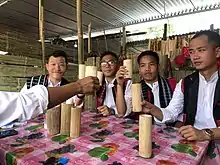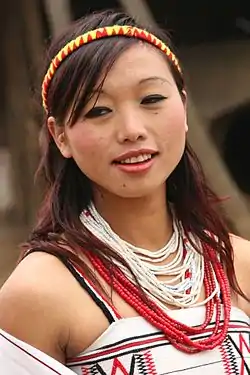Mishmi people
The Mishmi or Deng people of Tibet and Arunachal Pradesh are an ethnic group comprising mainly three tribes: Idu Mishmi (Idu Lhoba); Digaro tribe (Taraon, Darang Deng), and Miju Mishmi (Kaman Deng). The Mishmis occupy the northeastern tip of the central Arunachal Pradesh in Upper and Lower Dibang Valley, Lohit and Anjaw Districts. The three sub-divisions of the tribe emerged due to the geographical distribution, but racially all the three groups are of the same stock. The Idu are also known as Yidu Lhoba in Tibet and often referred as Chulikatas in Assam. The Idus are primarily concentrated in the Upper Dibang Valley and Lower Dibang Valley district and parts of the northern part of Lohit district of Arunachal Pradesh in India. Taraon, also called Digaru Mishmis, are distributed in the hill and the foothills between the Dibang, Digaru and the Lohit rivers. Kamans are also known as the Miju Mishmis; they live between the Lohit and the Kambang rivers in the foothills and in the Mishmi Hills on both sides of the Lohit river right up to the frontiers to Rima. There are around 30,000 of them in Arunachal Pradesh.

The Idu-Mishmi believes that Rukmini-Chief Consort of Lord Krishna belonged to their tribe.[1] The plays and dances on ‘Rukmini haran’ are common.There is a legend that Lord Krishna asked the Mishmi people to cut their hair as a form of punishment for not allowing him to marry Rukmini.Due to this Idu-Mishmi people are also called "chulikata" (chuli-hair, kata- cut).[2]
In China
The Deng people (or Dengba, Chinese transcription of Taraon-Kaman languages: 代巴玫; Chinese: 僜人; Hanyu pinyin: Dèng Rén) are not officially recognised by the government of People's Republic of China. They live in nine villages in Tibet's Zayu County and virgin forest areas between the Himalayas and the Hengduan Mountains at an elevation of 1000 meters. Bradley (2007) reports 800 ta˧˩ ʒuaŋ˥ (Chinese: Darang Deng) and 200 kɯ˧˩ mɑn˧˥ (Chinese: Geman Deng; known as the Kaman or Miju Mishmi in India) in China, one village in Burma where they are known as Taraung, and the Taraon, Tayin, or Tain (formerly Digaru Mishmi) in northeastern India.[3] Many of them have migrated from China to India.
In 1985, the Chinese government tried to have an expert study the Deng, but the 10th Panchen Lama said "All the people in Tibet should be Tibetans" and "To recognize any new ethnic groups is to split our Tibetans." As a result, the project has been abolished.[4]
Creation myth

很久以前,世界上一片茫茫大水,德饶高创造了大地,金人阿加尼与老鹰通婚,繁衍成了僜人。
Long ago, the world is a vast-flood. Deraogao created the earth, and the gold-people Ajiani married the eagle. Deng people are their offspring.
This is a story among Deng people. They believe their ancestor is Ajiani.
References
- https://arunachaltimes.in/index.php/2018/03/28/a-twist-in-the-myth-rukminis-vague-arunachal-connection/
- Roychowdhury, Adrija (29 March 2018). "Fact Check: Did Rukmini come from Arunachal Pradesh? Here is what we know". The Indian Express. Retrieved 26 November 2020.
- Bradley, David (2007). "Language Endangerment in China and Mainland Southeast Asia". In Matthias Brenzinger, ed. Language diversity endangered. New York: Mouton de Gruyter.
- "Deng people about to disappear," Archived 2012-07-12 at Archive.today National Geographic China magazine.
External links
| Wikimedia Commons has media related to Mishmi people. |
| Wikisource has the text of the 1905 New International Encyclopedia article "Mishmis". |
- RCILTS, IIT Guwahati
- Photo of two Miju Mishmi women
- Britannica entry of the Mishmi
- Internary reference on various localities of the Mishmi
- http://www.ethnic-china.com/Deng/dengindex.htm
- https://web.archive.org/web/20070518105343/http://zt.tibet.cn/tibetzt/ssmz_en/deng/001.htm
- ethnic-china.com
- zt.tibet.cn
